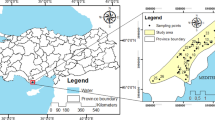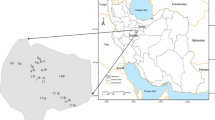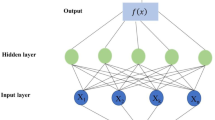Abstract
The knowledge of fluctuation of water table depth is highly required for proper planning and sustainable development of available water resources. This study intends to study groundwater behaviour under changing scenario in the lower part of Ganga–Ramganga interbasin. It also investigates the comparative performance of soft computing techniques, i.e. co-active neuro-fuzzy inference system (CANFIS), fuzzy logic and radial basis function network (RBFN), which are used for prediction of water table depth in the study area. Components of groundwater recharge and discharge along with seasonal water table depth covering a period of 23 years (1990–2012) are used to develop four combination sets of input variables. Different CANFIS structures, fuzzy logic rules and RBFN structures are applied to these combinations of input variables, and the best combinations are selected on the basis of the values of different performance indicators such as coefficient of determination (R2), mean absolute deviation, root mean square error, coefficient of variation of error residuals, Nash–Sutcliff efficiency, correlation coefficient (r), absolute prediction error and performance index. The result of this study indicates the superiority of fuzzy logic rule-based model than of CANFIS models and RBFN model in predicting water table depth.


















Similar content being viewed by others
Explore related subjects
Discover the latest articles, news and stories from top researchers in related subjects.References
Agricultural Refinance and Development Corporation, India (1979) Report of ground water over exploitation committee, Mumbai, pp 211–232
Ahmadi M, Saemi M (2008) Integration of genetic algorithm and a co-active neuro fuzzy inference system for permeability prediction from well logs data. Transp Porous Media 71(3):273–288
Alp M, Cigizoglu HK (2007) Suspended sediment load simulation by two artificial neural network methods using hydrometeorological data. Environ Model Softw 22:2–13
Anmala J, Zhang B, Govindaraju RS (2000) Comparisons of ANNs and empirical approaches for predicting watershed runoff. J Water Resour Plan Manag ASCE 126(3):156–166
Awasthi AK, Dubey OP, Awasthi A, Sharma S (2005) A Fuzzy Logic model for estimation of groundwater recharge. In: Annual meeting of the North American fuzzy information processing society, Detroit, MI, June 26–28, 2005, pp 809–813
Aytek A (2008) Co-active neuro fuzzy inference system for evapotranspiration modelling. Soft Comput Fusion Found Methodol Appl 13(7):691–700
Aziz K, Rahman A, Shamseldin AY, Shoaib M (2013) Co-active neuro fuzzy inference system for regional flood estimation in Australia. J Hydrol Environ Res 1(1):11–20
Bahat M, Inbar G, Yaniv O, Schneider M (2000) A fuzzy irrigation controller system. Eng Appl Artif Intell 13:137–145
Bardossy A, Bronstert A, Merz B (1995) 1, 2 and 3-dimensional modelling of water movement in the unsaturated soil matrix using a Fuzzy approach. Adv Water Resour 18(4):237–251
Bear J, Beljin MS, Ross RR (1992) Ground water issue, United States Environmental Protection Agency, EPA/540/S-92/005
CGWB (2009) Status report on review of ground water resources estimation methodology. Central Ground Water Board, Faridabad, India. http://www.indiaenvironmentportal.org.in/files/Statusreport_reviewmethodologycombined.pdf. Accessed 23 Oct 2018
Cobaner M, Unal B, Kisi O (2009) Suspended sediment concentration estimation by an adaptive neuro-fuzzy and neural network approaches using hydro-meteorological. J Hydrol 367:52–61
Elshorbagy A, Simonovic SP, Panu US (2000) Performance evaluation of ANNs for runoff prediction. J Hydrol Eng 5(4):424–427
Ferrari S, Bellocchio F, Piuri V, Borghese NA (2010) A hierarchical RBF online learning algorithm for real-time 3-D scanner. IEEE Trans Neural Netw 21(2):275–285
Ghose DK, Panda SS, Swain PC (2010) Prediction of water table depth in western region, Orissa using BPNN and RBFN neural networks. J Hydrol 394:296–304
Ground Water Department, Geohydrological Division, Uttar Pradesh (1999) Report on estimation of groundwater resources as per methodology-1997 in district Moradabad. Bareilly, T.M.No. 295/98-99
Han HG, Chen Ql, Qiao JF (2011) An efficient self-organizing RBF neural network for water quality prediction. Neural Netw 24:717–725
Haykin S (2004) Neural networks, a comprehensive foundation, 2nd edn. Prentice Hall, Upper Saddle River
Heydari M, Talaee PH (2011) Prediction of flow through rockfill dams using a neuro fuzzy computing technique. J Math Comput Sci 2(3):515–528
Hong YS, Rosen MR, Reeves RR (2002) Dynamic fuzzy modelling of storm water infiltration in urban fractured aquifer. J Hydrol Eng 7(5):380–391
Huang GB, Saratchandran P, Sundararajan N (2004) An efficient sequential learning algorithm for growing and pruning RBF (GAP-RBF) networks. IEEE Trans Syst Man Cybern Part B Cybern 34(6):2284–2292
Igboekwe MU, Uhegbu AC (2011) Fundamental approach in groundwater flow and solute transport modelling using the finite difference method. In: IA Dar (ed) Earth and environmental sciences. InTech, Europe, p 630
Jang JSR, Sun CT, Mizatani E (1997) Neuro-Fuzzy and soft computing. A computational approach to learning and machine intelligence. Prentice Hall, Upper Saddle River, p 614p
Jihong Q, Juan Z, Nanxiang C (2010) Groundwater table prediction based on improved PSO Algorithm and RBF Neural Network. In: International conference on artificial intelligence and computational intelligence. Sanya, October 23–24, vol 1, pp 228–232
Jyothiprakash V, Ramchandran MR, Shanmuganathan P (2002) Artificial neural network model for estimation of REFET. J Inst Eng (India) 83:17–24
Kisi O (2009) Daily pan evaporation modelling using multi-layer perceptrons and radial basis neural networks. Hydrol Process 23(2):213–223
Kumar M, Raghuwanshi NS, Singh R, Wallender WW, Pruitt WO (2002) Estimating evapotranspiration using artificial neural network. J Irrig Drain Eng ASCE 128(4):224–233
Lee CM, Ko CN (2009) Time series prediction using RBF neural networks with a nonlinear time-varying evolution PSO algorithm. Neurocomputing 73(1–3):449–460
Liu Y, Zhang C (1993) A comparative study of calculation methods for recharge of rainfall seepage to ground water in plain area. Ground Water 31(1):12–18
Malik A, Kumar A (2015) Pan evaporation simulation based on daily meteorological data using soft computing techniques and multiple linear regression. Water Resour Manag 29:1859–1872
Mamdani E, Assilian S (1975) An experiment in linguistic synthesis with a fuzzy logic controller. Int J Man Mach Stud 7:1–13
Manikumari N, Murugappan A (2008) Fuzzy logic based model for optimization of tank irrigation system. J Eng Appl Sci 3(2):199–202
Ministry of Water Resources, India (2009) Report of the ground water resource Estimation Committee. New Delhi, p 133
Nayak PC, Satyaji YR, Sudheer KP (2006) Groundwater level forecasting in a shallow aquifer using artificial neural network approach. Water Resour Manag 20:77–90
Nourani V, Moghaddam AA, Nadiri AO, Singh VP (2008) Forecasting spatiotemporal water levels of Tarbiz aquifer. Trends Appl Sci Res 3(4):319–329
Ozelkan EC, Duckstein L (2001) Fuzzy conceptual rainfall-runoff models. J Hydrol 253:41–68
Praveena SM, Abdullah MH, Aris AZ, Bidin K (2010) Groundwater solution techniques: environmental applications. J Water Resource Prot 2(1):1–6
Prickett TA (1976) Advances in groundwater flow modeling. In: 12th Symposium of AWRA, Septmber 23, 1976, Chicago, Illinois
Prickett TA (1979) Ground water computer model-state of art. Ground Water. 17(2):167–173
Qian XX, Zhu XY (1987) Determination of rainfall seepage recharge capacity in evaluating ground water resources. Researches on theory-method of ground water resource evaluation. Geological Publishing House, Beijing, pp 120–129
Rushton KR, Redshaw SC (1979) Seepage and groundwater flow. Wiley, Chichester, New York
Safavi HR, Chakraei I, Samani AK, Golmohammadi MH (2013) Optimal reservoir operation based on conjunctive use of surface water and groundwater using neuro fuzzy systems. Water Resour Manag 27:4259–4275
Sarkar R, Kumar S, Kumar Y, Sharma HC (2007) Comparative performance of Artificial Neural Network and statistical approach in groundwater modelling for Ramganga Bahgul interbasin. J Appl Hydrol XX(4):71–82
Saruwatari N, Yomota A (1995) Forecasting system of irrigation water on paddy field by fuzzy theory. Agric Water Manag 28:163–178
Sethi RR, Kumar A, Sharma SP, Verma HC (2010) Prediction of water table depth in a hard rock basin by using artificial neural network. Int J Water Resour Environ Eng 2(4):95–102
Singh AK, Nestmann F, Eldho TI (2004) Estimating hydrological parameters for Anas catchment from watershed characteristics. In: International conference on advanced modelling technique for sustainable management of water resources, January 28–30, pp 30–33
Sreekanth PD, Geethanjali N, Sreedevi PD, Ahmed S, Kumar NR, Jayanthi PDK (2009) Forecasting groundwater level using artificial neural networks. Curr Sci 96(7):933–939
Staiano A, Inneguale F (2017) An RBF neural network-based system for home smart metering. In: IEEE international conference on fuzzy systems (FUZZ-IEEE), pp 1–6. https://doi.org/10.1109/fuzz-ieee.2017.8015645
Subrahmanya KCSV, Viswanadh GK (2004) Rainfall runoff modelling for Osman sagar catchment using ANN. In: International conference on advanced modelling technique for sustainable management of water resources, Jan 28–30, pp 26–29
Sudheer KP, Gosain AK, Ramashastri KS (2003) Estimating actual evapotranspiration from limited climatic data using neural computing technique. J Irrig Drain Eng ASCE. 129(3):214–218
Tabari MR, Ebadi T, Maknoun R (2011) Development of a smart model for groundwater level prediction based on aquifer dynamic conditions. Water Wastewater Winter 21(4):70–80
Tabari H, Talaee PH, Abghari H (2012) Utility of co-active neuro fuzzy inference system for pan evaporation modeling in comparison with multi layer perceptron. Meteorol Atmos Phys 116:147–154
Takagi T, Sugeno M (1985) Fuzzy identification of systems and its applications to modelling and control. IEEE Trans Syst Man Cybern Syst 15:116–132
Talaee PH (2014) Daily soil temperature modeling using Neuro Fuzzy approach. Theor Appl Climatol 118:481–489
Tfwala SS, Wang YM, Lin YC (2013) Prediction of missing flow records using multilayer perceptron and co-active neuro fuzzy inference system. Sci World J. Article ID 584516
Tuhami AE, Mohamed HI (2008) Groundwater levels estimation at areas affected by new Naga Hammadi barrages using ANN method. In: Twelfth international water technology conference, Alexandria, Egypt
Uddameri V (2007) Using statistical and artificial neural network models to forecast potentiometric levels at a deep well in South Texas. Environ Geol 51:885–895
Walton WC (1970) Groundwater resource evaluation. McGraw-Hill Book Co., New York
Wang SW, Yu DL (2008) Adaptive RBF network for parameter estimation and stable air–fuel ratio control. Neural Netw 21(1):102–112
Wang Y, Traore S, Kerh T (2008) Neural network approach for estimating reference evapotranspiration from limited climatic data in Burkina Faso. WSEAS Trans Comput 6(7):704–713
Weesakul U, Watanabe K, Sukasem N (2010) Application of soft computing techniques for analysis of groundwater table fluctuation in Bangkok area and its vicinity. Int Trans J Eng Manag Appl Sci Technol 1(1):53–65
Yoon H, Chun Jun S, Hyun Y, Bae GO, Lee KK (2011) A comparative study of artificial neural networks and support vector machines for predicting groundwater levels in a coastal aquifer. J Hydrol 396:128–138
Zadeh LA (1965a) Fuzzy sets. Inf Control 8:338–353
Zadeh LA (1965b) Fuzzy sets and systems. In: Proceeding of the symposium on system theory, polytechnic institute of Brooklyn, New York, pp 29–39
Zadeh LA (1968) Fuzzy algorithms. Inf Control 12:94–102
Zadeh LA (1969) Note on fuzzy languages. Inf Sci 1:421–434
Zadeh LA (1972) A fuzzy-set-theoretic interpretation of linguistic hedges. J Cybern 2(3):4–34
Zadeh LA (1975) Fuzzy logic and approximate reasoning. Synthese 30(3–4):407–428
Acknowledgements
The authors wish to express their sincere thanks to Groundwater Department of Uttar Pradesh for providing water table depth data, Nazarat of district headquarters of Uttar Pradesh for providing rainfall data and Department of Planning, Directorate of Economics and Statistics Division, Uttar Pradesh, for providing all statistical data related to this research. The authors also gratefully acknowledge the constructive comments of the associate editor and three anonymous reviewers which improved the manuscript considerably.
Author information
Authors and Affiliations
Corresponding author
Ethics declarations
Conflict of interest
The authors declare that there is no conflict of interests regarding the publication of this paper.
Ethical approval
This article does not contain any studies with human participants or animals performed by any of the authors.
Additional information
Communicated by V. Loia.
Rights and permissions
About this article
Cite this article
Pradhan, S., Kumar, S., Kumar, Y. et al. Assessment of groundwater utilization status and prediction of water table depth using different heuristic models in an Indian interbasin. Soft Comput 23, 10261–10285 (2019). https://doi.org/10.1007/s00500-018-3580-4
Published:
Issue Date:
DOI: https://doi.org/10.1007/s00500-018-3580-4




